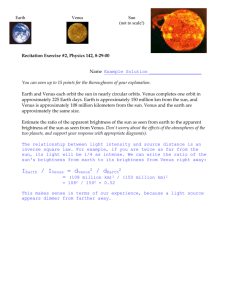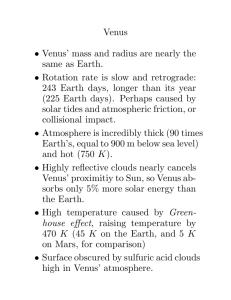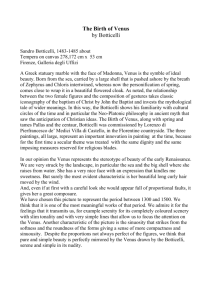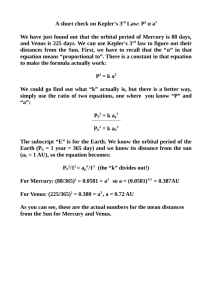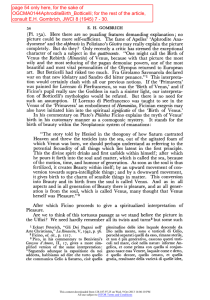Prova teorica J+S n.1 Recently, on June 6, 2012 an infrequent
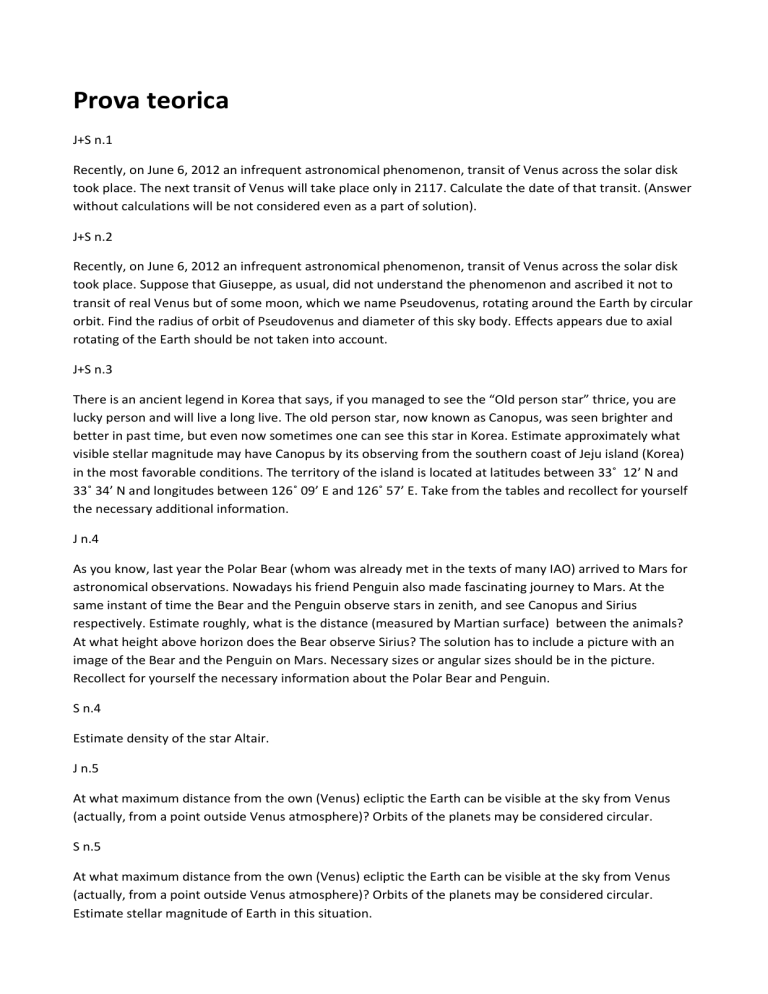
Prova teorica
J+S n.1
Recently, on June 6, 2012 an infrequent astronomical phenomenon, transit of Venus across the solar disk took place. The next transit of Venus will take place only in 2117. Calculate the date of that transit. (Answer without calculations will be not considered even as a part of solution).
J+S n.2
Recently, on June 6, 2012 an infrequent astronomical phenomenon, transit of Venus across the solar disk took place. Suppose that Giuseppe, as usual, did not understand the phenomenon and ascribed it not to transit of real Venus but of some moon, which we name Pseudovenus, rotating around the Earth by circular orbit. Find the radius of orbit of Pseudovenus and diameter of this sky body. Effects appears due to axial rotating of the Earth should be not taken into account.
J+S n.3
There is an ancient legend in Korea that says, if you managed to see the “Old person star” thrice, you are lucky person and will live a long live. The old person star, now known as Canopus, was seen brighter and better in past time, but even now sometimes one can see this star in Korea. Estimate approximately what visible stellar magnitude may have Canopus by its observing from the southern coast of Jeju island (Korea) in the most favorable conditions. The territory of the island is located at latitudes between 33˚ 12’ N and
33˚ 34’ N and longitudes between 126˚ 09’ E and 126˚ 57’ E. Take from the tables and recollect for yourself the necessary additional information.
J n.4
As you know, last year the Polar Bear (whom was already met in the texts of many IAO) arrived to Mars for astronomical observations. Nowadays his friend Penguin also made fascinating journey to Mars. At the same instant of time the Bear and the Penguin observe stars in zenith, and see Canopus and Sirius respectively. Estimate roughly, what is the distance (measured by Martian surface) between the animals?
At what height above horizon does the Bear observe Sirius? The solution has to include a picture with an image of the Bear and the Penguin on Mars. Necessary sizes or angular sizes should be in the picture.
Recollect for yourself the necessary information about the Polar Bear and Penguin.
S n.4
Estimate density of the star Altair.
J n.5
At what maximum distance from the own (Venus) ecliptic the Earth can be visible at the sky from Venus
(actually, from a point outside Venus atmosphere)? Orbits of the planets may be considered circular.
S n.5
At what maximum distance from the own (Venus) ecliptic the Earth can be visible at the sky from Venus
(actually, from a point outside Venus atmosphere)? Orbits of the planets may be considered circular.
Estimate stellar magnitude of Earth in this situation.
J n.6
In our part of the galaxy the mean distance between the stars is about 6 light years. Assume that an interferometer can measure parallaxes with an error of ±0.001 arc second. How many stars of our Galaxy could have their parallax determined by this interferometer?
S n.6
Astronomers have discovered a distant galaxy that in Earth’s sky at first glance looks like ε Eridani, the same in colour, but 1000 times less in intensity. It appears, however, that this galaxy is composed only of the stars similar to the Sun in physical characteristics. Find the number of stars in the galaxy.
NB: per alcuni esercizi sono necessarie le tabelle da allegare……
Prova osservativa
Cloudy Sky
9. Indica con il dito la direzione dei seguenti oggetti:
9.1: la stella polare
9.2: l’eclittica
10. Passa ora al telescopio:
10.1: Allinea il cercatore in modo che sia allineato perfettamente. Dopo aver finito l’allineamento, mostra il telescopio all’esaminatore.
10.2: Scrivi qui sotto il numero scritto in un posto distante che ti verrà indicato dall’esaminatore.
11. Stima la distanza zenitale aprossimativa di mercurio
Clear Sky
9. Indica con il dito la direzione dei seguenti oggetti:
9.1: la stella polare
9.2: l’eclittica
10. Al telescopio punta NGC869 e NGC884. Una volta fatto mostralo all’esaminatore.
10.2 Stima l’attuale angolo orario di entrambi (10 gradi di accuratezza) e scrivile nel riquadro
11. Punta M15 con il telescopio. Ti viene data una mappa del cielo. Dopo aver identificato l’oggetto, mostralo all’esaminatore.
12. Stima la distanza zenitale aprossimativa di mercurio



